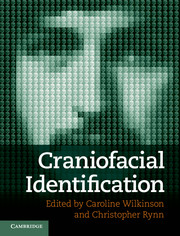Book contents
- Frontmatter
- Contents
- Contributors
- Part I Identification of the Living
- Part II Identification of the Dead
- Chapter 14 Post-mortem prediction of facial appearance
- Chapter 15 Manual forensic facial reconstruction
- Chapter 16 Relationships between the skull and face
- Chapter 17 Automated facial reconstruction
- Chapter 18 Computer-generated facial depiction
- Chapter 19 Craniofacial superimposition
- Chapter 20 Juvenile facial reconstruction
- Index
- Plate Section
- References
Chapter 16 - Relationships between the skull and face
Published online by Cambridge University Press: 05 May 2012
- Frontmatter
- Contents
- Contributors
- Part I Identification of the Living
- Part II Identification of the Dead
- Chapter 14 Post-mortem prediction of facial appearance
- Chapter 15 Manual forensic facial reconstruction
- Chapter 16 Relationships between the skull and face
- Chapter 17 Automated facial reconstruction
- Chapter 18 Computer-generated facial depiction
- Chapter 19 Craniofacial superimposition
- Chapter 20 Juvenile facial reconstruction
- Index
- Plate Section
- References
Summary
Introduction
Craniofacial reconstruction (CFR) and approximation (CFA) are among terms commonly used to describe the procedure of predicting and recreating a likeness of an individual face based on the morphology of the skull (Gerasimov, 1955; Krogman and İşcan, 1986; Wilkinson, 2004). A variety of methods exist, most of which employ averaged tissue-depth data at various landmarks of the skull, and feature prediction guidelines to estimate the morphology of the eyes, nose, mouth and ears. Some methods also entail interpretation of general and local skull morphology to predict individual muscles of mastication and facial expression. This chapter will describe craniofacial patterns, and discuss anatomical and morphological interrelationships between the skull and the face, such as may be useful in craniofacial reconstruction.
A key principle of anatomy is that structure is inextricably related to function. Every organ, indeed every organelle in every cell in every biological organism, has been gradually evolving its way into a functional niche through the process of natural selection over innumerable generations. The human head is anatomically and architecturally fascinating because of the wide range of functions carried out by its constituent parts. Organs dedicated to four of the five special senses are housed in the craniofacial complex: the eyes (vision), the inner, middle and outer ears (audition/balance), the mouth and oropharynx (gustation/mastication/respiration/verbalisation) and the nasopharyngeal airway (olfaction/respiration), and the functionality of each is responsible in part for the structure of the head and face. The eyes of a child appear much larger and further apart than those of an adult; of course, this is only relative to the rest of the face, but the eyes must develop to a certain level, and thus a certain size, in order to function, and must be a certain distance apart for effective binocular vision, so this structural arrangement is set up early and maintained throughout development. However, the nose, mouth and lower face change shape quite drastically between infancy and adulthood, but remain functional throughout development via a series of compensatory mechanisms involving the entire craniofacial complex.
- Type
- Chapter
- Information
- Craniofacial Identification , pp. 193 - 202Publisher: Cambridge University PressPrint publication year: 2012
References
- 3
- Cited by



